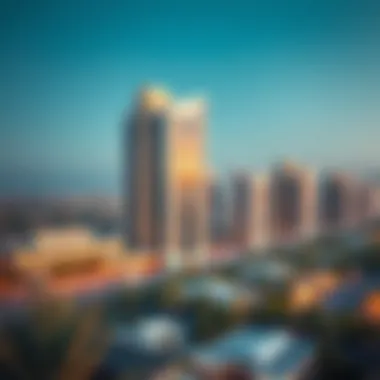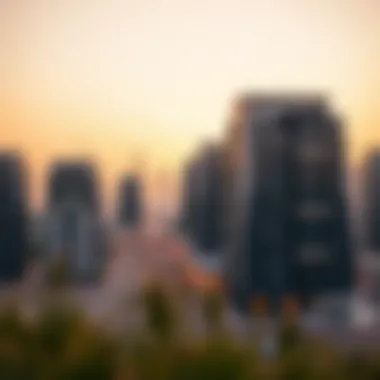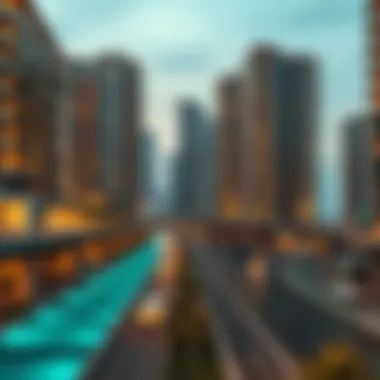Exploring the Future of UAE's Real Estate Projects


Intro
The landscape of real estate projects in the UAE, particularly in Dubai, is not just a realm of skyscrapers and luxurious villas. It's a bustling tapestry woven with aspirations, market dynamics, and a host of intricate details that demand attention. As trends shift and new opportunities unfold, understanding this landscape becomes indispensable for investors, homeowners, and real estate professionals alike. The developments in this vibrant market tell a story, and it's one that is constantly evolving.
With a surge in both local and international interest, the real estate sector in Dubai has witnessed a renaissance of sorts. Not only is there an influx of cutting-edge architecture, but there's also a palpable shift towards sustainable living and integrated communities. This article aims to explore the key driving forces behind these changes and the implications they hold for various stakeholders in the market.
Overview of UAE's Real Estate Sector
The real estate sector in the UAE has long been a cornerstone of the nation's economic framework. Particularly in cities like Dubai and Abu Dhabi, the vibrancy of the property market is influenced by a confluence of factors ranging from luxury developments to practical housing solutions. This sector is not just about concrete structures; it represents aspirations, economic vitality, and investment potential.
Understanding this landscape is crucial for a multitude of stakeholders. Whether you’re an investor eyeing savvy deals, a real estate agent navigating the shifting terrain, or a homeowner seeking reassurance, grasping the intricacies of the UAE’s market is essential.
Key elements that deserve attention include:
- Diverse Offerings: From high-rise luxury condos to suburban housing developments, there's something for everyone.
- Market Resilience: History has shown that the sector tends to bounce back from downturns, often with surprising swiftness.
- Foreign Investment Dynamics: With regulations favoring overseas buyers, the market remains accessible, fostering global interest.
Current Market Trends
The current real estate landscape in the UAE is characterized by a duality of luxury and functionality. Recent reports indicate a growing demand for both affordable housing and premium properties. Such trends reflect shifting demographics and changing consumer expectations. For instance, many expatriates are seeking suburbs with easy access to urban amenities while balancing budget constraints.
Hot spots include:
- Dubai Marina: Continues to attract high-end buyers.
- Jumeirah Village Circle: Gaining traction for affordable family housing.
- Abu Dhabi’s Al Reem Island: Emerging as a key player for residential apartments.
Moreover, luxury developments remain attractive to investors, resulting in high returns. However, the focus is shifting toward sustainable and smart living. Overall, the diversity of projects and customer preferences significantly shapes today's trends.
Key Economic Indicators
The health of the UAE real estate market can largely be assessed through several critical economic indicators. Monitoring these figures provides insights about growth potential and market vitality. Primarily, the following indicators stand out:
- GDP Growth Rate: A positive trajectory in the Gross Domestic Product often correlates with a robust demand for properties.
- Population Growth: Continued influx of expatriates drives housing demand; a stable population rate indicates a sustainable market.
- Rental Yields: These figures remain high, making the UAE attractive for buy-to-let investors.
As these indicators are monitored, it becomes evident that the landscape is ever-evolving and responds sensitively to broader economic shifts, both locally and globally.
Impact of Global Events
Global events play a significant role in shaping the UAE real estate landscape. Factors such as geopolitical dynamics, fluctuations in oil prices, and global economic shifts can ripple through the market. For instance, the COVID-19 pandemic showcased both vulnerabilities and resilience. Initially, there was a downturn in transactions, but the subsequent recovery pointed to a strong pent-up demand.
- Geopolitical factors: Regional stability enhances investor confidence.
- Economic policies: Initiatives aimed at diversifying the economy from oil dependency influence real estate viability.
- Post-pandemic shifts: Changes in buyer priorities, like an increased preference for larger properties, reflect evolving lifestyles.
In sum, the intricate tapestry of local and global events paints a complex but insightful picture of the ongoing transformation within the UAE real estate sector.
Major Real Estate Projects
When one thinks about the UAE, especially Dubai, the term "major real estate projects" springs to mind. This is not just about constructing buildings. It embodies a vision, a strategic maneuver to elevate the UAE's standing as a world-class hub for business, tourism, and innovation. Major projects act as catalysts for economic growth, attracting investors and creating job opportunities, shaping not only the skyline but also the socio-economic fabric of the region. The critical importance of examining these projects lies in understanding how they interlink with regional development goals, economic diversification, and ultimately, global competitiveness.
Iconic Developments in Dubai
Dubai is often synonymous with luxury and innovation, and its skyline is like a treasure trove of iconic structures. Take the Burj Khalifa, for instance—towering over the city at 828 meters. It’s not just a building; it represents the spirit of ambitious human endeavor. Projects like the Palm Jumeirah, a stunning feat of engineering, have turned the desert into a tropical paradise, presenting opulent residences and luxurious hotels. Furthermore, the ongoing development of Dubai Creek Tower, projected to surpass even the Burj Khalifa, is testament to the emirate’s vision for growth.
Investment opportunities within these iconic developments are remarkable. Not only do they offer potential high returns, but they also present an attractive lifestyle—perfect for expatriates and investors alike. The real estate market in Dubai continues to evolve with these projects, constantly providing new avenues for investment.


In addition to their grand designs, the significance of community infrastructure cannot be overlooked. Such projects usually incorporate schools, hospitals, and parks that enhance the living experience, making them appealing to a broader market segment.
Innovations in Abu Dhabi's Skyline
Moving beyond Dubai, Abu Dhabi is making its own mark with innovative projects that redefine urban living. The development of Al Maryah Island represents the capital's aim to merge urban life with waterfront tranquility. Here, luxury residential options coexist with retail space and cultural offerings.
Yas Island, home to attractions like Ferrari World and Yas Waterworld, sees ongoing development aimed at bolstering its appeal as a tourist hotspot. The introduction of sustainable building practices has gained momentum as well, with projects aimed towards achieving green certification, positioning the city as a forward-thinking and environmentally friendly destination.
Abu Dhabi's bold step towards diversifying its economy reflects prominently in its skyline, where traditional architecture meets modern design. This not only attracts local and international investments but also appeals to a cosmopolitan demographic eager for unique living experiences.
Emerging Markets in Sharjah
Often considered the cultural heart of the UAE, Sharjah is rapidly emerging as a noteworthy player in the real estate landscape. The government is pushing for development that aligns with cultural and educational initiatives, making it an attractive option for families and businesses alike. Projects like Al Zahia residential community aim to foster a balanced lifestyle, integrating leisure with day-to-day living.
Additionally, significant infrastructural developments, such as the Sharjah Sustainable City, focus on eco-friendly living science. They echo a growing trend towards sustainability which appeals to a more environmentally conscious investor base.
Sharjah also benefits from its proximity to both Dubai and Ajman, making it highly accessible. With affordable living options, it is becoming a magnet for those priced out of the Dubai market. The synergy between cultural enrichment and economic opportunities is indeed paving a solid pathway for growth in the region.
Major real estate projects in the UAE aren't just structures; they're beacons of economic progress, cultural innovation, and future possibilities.
In summary, the major real estate projects in the UAE offer a glimpse into a prosperous future driven by vision and creativity. By evaluating these developments, investors can obtain deeper insights into market dynamics and future trends.
Sustainable Development Initiatives
Sustainability is no longer just a buzzword; it has become a guiding principle in the architectural landscape of the UAE. With the region facing rapid urbanization and population growth, the need for responsible development has never been more crucial. Sustainable development initiatives not only contribute to environmental conservation but also create economic value and enhance the quality of life for residents.
Adopting a sustainability framework in the real estate sector plays a vital role in minimizing carbon footprints. Furthermore, it sets a precedent for a future where development is harmonized with nature. The emphasis on sustainability encourages developers to think critically about resource use, energy consumption, and environmental impact.
Key elements of these initiatives include:
- Adaptive reuse of buildings: Transforming older structures into modern spaces while retaining their historical significance minimizes waste.
- Integration with nature: Designing projects that embrace green spaces, such as parks and community gardens, fosters biodiversity.
- Community engagement: Involving local communities in the planning process ensures developments meet their needs while building a sense of ownership and responsibility.
Benefits of Sustainable Development Initiatives
Sustainable initiatives provide multiple benefits
- Economic advantages: Green buildings often reduce operating costs by improving energy efficiency. Operational savings can prove invaluable over the long term, making them attractive to investors.
- Enhanced property value: Properties that meet higher sustainability standards often command higher prices in the market. Buyers increasingly seek homes and offices that align with their values.
- Healthier living environments: The emphasis on green architecture can lead to better air quality and overall wellness for residents.
Considerations regarding Sustainable Development Initiatives
Despite their importance, there are considerations to keep in mind. The initial investment in sustainable projects may be higher, deterring some developers. However, with long-term savings and governmental incentives in place, many are starting to see beyond short-term costs. Additionally, there is a crucial balance to be struck between development speed and sustainable practices, as rushing can lead to missed opportunities for incorporating sustainable innovations effectively.
"The shift towards sustainable practices is not merely a trend but a necessity in today's world. Collaborations among policymakers, developers, and communities can foster a more sustainable urban environment in the UAE."
Green Building Certifications
Green building certifications, such as LEED (Leadership in Energy and Environmental Design) and Estidama, signify that a building has met rigorous sustainability standards. These certifications evaluate various aspects, including energy use, water quality, indoor air quality, and materials used.
In the UAE, Estidama plays a crucial role, as it caters specifically to the regional climate and cultural context. It aims to enhance the sustainability of buildings while preserving the environment. The Pearl Rating System, part of Estidama, certifies projects across different sustainability benchmarks, motivating builders to achieve higher levels of energy efficiency and sustainable living.
Benefits of obtaining such certifications include:


- Attracting green-conscious tenants: Tenants are often wary of buildings with a heavy environmental footprint. A green certification signifies sustainability commitment.
- Possible financial incentives: Certain governments offer grants or tax reductions for certified buildings, which can help recuperate initial investments.
Smart City Projects
Smart city projects in the UAE are carving out a path for a technology-driven future. Featuring cutting-edge infrastructure, these initiatives focus on data integration, connectivity, and efficiency. Cities like Dubai and Abu Dhabi are pioneers in adopting smart technologies that improve city living.
Key aspects of smart city projects include:
- IoT Integration: By employing the Internet of Things, cities can manage resources better and enhance day-to-day experiences for residents.
- Sustainable mobility: Projects feature electric public transport systems, bike-sharing options, and pedestrian-friendly routes to promote eco-friendly travel.
Investing in smart city infrastructure harnesses the power of technology while addressing sustainability. As the UAE continues to evolve, these initiatives will play a leading role in shaping a more connected and responsible urban landscape.
Investment Opportunities
Exploring investment opportunities within the UAE's real estate landscape is pivotal for anyone looking to navigate this vibrant market. With its rapid development and increasing global visibility, the UAE is emerging as a lucrative hub for investors, homeowners, and real estate professionals alike. Here we delve into various aspects that make this topic not only relevant but critical for informed decision-making.
Residential Sector Analysis
The residential real estate sector in the UAE has witnessed significant transformation over the years. With diverse options ranging from luxury villas to affordable apartments, there's something for every pocket. Investors often flock to areas such as Dubai Marina and Jumeirah Village Circle, both known for their attractive returns on investment. Additionally, the introduction of affordable housing projects has opened new avenues, catering to first-time buyers and those looking to capitalize on the rental market.
The following factors play a vital role in shaping the residential investment landscape:
- High Rental Yields: Many areas in Dubai boast rental yields that are among the highest in the world, making it a prime choice for property investors.
- Regulatory Environment: Laws that favor foreign investors, such as freehold property ownership, further enhance the appeal of investing in residential properties.
- Strong Demand: The continuous influx of expatriates and tourists keeps the demand for rental properties robust, ensuring steady occupancy rates.
Commercial Real Estate Prospects
In terms of commercial real estate, the UAE is on an upward trajectory. From office spaces in the Central Business District to retail properties in expansive malls, the demand remains high. The Expo 2020 and subsequent events have stimulated business growth, leading to higher leasing rates, particularly in Dubai.
Several elements are noteworthy when considering commercial real estate investment:
- Diverse Market Needs: The transition to remote working has increased interest in flexible office solutions, as businesses adapt to new realities.
- Government Initiatives: The UAE's various free zones facilitate foreign ownership and make starting a business easier, further driving the need for commercial spaces.
- Visitor Economy: The robust tourism sector leads to a demand for retail spaces, especially in prime locations like The Avenues and Mall of the Emirates, making retail a golden opportunity for investors.
Altogether, commercial real estate in the UAE presents a prominent investment avenue, boosted by business-friendly policies and a thriving economy.
Tourism and Hospitality Investments
The tourism industry in the UAE continues to thrive, underpinned by remarkable attractions, world-class events, and a strategic location. This trend spells significant investment opportunities in hospitality, ranging from luxury hotels to budget accommodations.
Several components make tourism-related investments compelling:
- Event-Driven Demand: Major events, like the World Expo and international sporting events, draw millions of visitors, creating a surge in accommodation needs.
- Government Support: The UAE government's efforts to promote tourism development and infrastructure improvements have resulted in an enhanced travel experience.
- Diversified Offerings: Beyond luxury resorts, the rise of eco-friendly lodges and boutique hotels caters to changing consumer preferences.
Furthermore, tremendous developments like the Palm Jumeirah and the upcoming Red Sea Project signal immense potential in the hospitality sector, making it a prime target for potential investors.
"Investing in the UAE's tourism sector is akin to planting a seed in fertile soil; the returns will flourish as the sector grows."
Ultimately, the UAE’s real estate investment landscape is filled with promise, characterized by diverse opportunities that cater to a wide array of investor needs and preferences. Understanding the nuances of residential, commercial, and hospitality sectors can significantly enhance investment outcomes.
Regulatory Framework and Policies
Navigating the real estate landscape in the UAE requires a solid understanding of its regulatory framework and policies. The rules governing property ownership, investment incentives, and changes in legislation play a pivotal role in shaping the market dynamics within this rapidly evolving sector. A clear grasp of these regulations is indispensable for investors, homeowners, and real estate professionals aiming to make informed decisions.


Ownership Laws and Regulations
In the UAE, property ownership laws can be a bit of a maze for newcomers. Each emirate has its own set of laws regarding who can own property and under what conditions. For instance, Dubai allows foreign nationals to own freehold properties in designated areas, while Abu Dhabi imposes stricter regulations and limits foreign ownership primarily to leasehold agreements. Understanding these differences is essential.
Key points to consider:
- Freehold vs. Leasehold: Foreigners can purchase freehold in Dubai, but predominantly leasehold in Abu Dhabi.
- Designated Zones: Only certain areas in each emirate allow foreign ownership.
- Property Titles: It's vital to ensure that title deeds are clear and legitimate to avoid disputes.
The legal landscape is not static; it evolves based on the fluctuating demands of the market and government policies.
Investment Incentives
The UAE government actively encourages investment in the real estate sector through various incentives. These policies aim to attract both local and foreign investors keen on residential and commercial properties. For example, offering long-term residency visas to property owners is a strategic move that reinforces the country’s commitment to fostering a favorable investment climate.
Investment incentives include:
- Long-term Visa Programs: Investors can gain residency through property ownership.
- Tax Benefits: Minimal taxation on income generated from real estate investments attracts buyers.
- Ease of Doing Business: Streamlined processes for property transactions make it easier for investors to navigate the legalities.
These incentives not only make the UAE an appealing destination for foreign investment but also promote a more diverse and competitive market.
Impact of Recent Legislative Changes
Legislative changes can reshape the real estate landscape fundamentally. Recent reforms, driven by the government’s aim to boost economic diversification and attract investments, have introduced measures ranging from changes to ownership laws to the implementation of new taxation systems.
Noteworthy changes include:
- Amendments to Property Laws: Adjustments allowing longer lease terms and clearer guidelines for multi-ownership models.
- Introduction of Value Added Tax (VAT): Aimed at increasing transparency in transactions, the VAT has been a hot topic among real estate investors.
- Increased Regulation on Short-Term Rentals: As platforms like Airbnb gain traction, new rules are emerging to manage this segment effectively.
Recent changes are essential for keeping the market aligned with global trends and ensuring investor confidence without compromising quality of life and governance in the UAE.
The regulatory framework is a double-edged sword. While it ensures market stability and protection for all parties involved, it’s crucial for stakeholders to stay abreast of these evolving rules to seize opportunities in a competitive market.
Understanding these regulatory parameters not only helps mitigate risks but also allows investors and homeowners to strategize effectively within the UAE’s dynamic real estate landscape. For more insights into property laws and investment incentives, visit Wikipedia or check guidelines on gov.ae.
By grasping the nuances of ownership laws, investment incentives, and legislative impacts, individuals can navigate the complexities of the UAE real estate sector with confidence.
Future Trends and Projections
As the UAE continues to develop and modernize, understanding Future Trends and Projections in real estate becomes crucial for anyone involved in the market—be it investors, homeowners, or real estate agents. By analyzing ongoing trends and anticipating future trajectories, stakeholders can effectively navigate the complexities of the market. This section aims to highlight the significance of recognizing emerging patterns that influence decision-making. These insights are vital in fostering confident investments and strategic choices.
Technological Advancements
In recent years, technological innovations have profoundly impacted the way real estate operates in the UAE. Integrating technologies such as artificial intelligence, virtual reality, and blockchain is not just a trend; it's reshaping the groundwork of transactions and building management.
- Smart Homes: Many new developments are incorporating smart technologies—think voice-activated systems, energy-efficient appliances, and automated security systems. This not only enhances living quality but also represents a shift in buyer preferences towards tech-savvy habitats.
- Virtual Tours: Virtual reality is changing the landscape for property viewings. Especially pertinent since the COVID-19 pandemic, these virtual platforms enable potential buyers to experience homes from the comfort of their couches, which could increase market reach.
- Blockchain for Transactions: Adopting blockchain technology in real estate transactions can enhance transparency and security. Traditionally, property transfers have required extensive paperwork; blockchain can streamline processes, reducing both time and potential for fraud.
Furthermore, these advancements are not just beneficial for buyers or renters; they bring efficiency and cost-reduction to property developers and brokers as well. With tech-driven insights, they can better analyze market trends and consumer behaviors, enabling more strategic project offerings.
Predicted Market Shifts
Looking ahead, the UAE’s real estate landscape is expected to undergo significant shifts prompted by various factors including economic recovery post-pandemic, regulatory changes, and evolving consumer demands. Recognizing these shifts will allow stakeholders to position themselves favorably.
- Rise of Suburban Areas: As remote work becomes commonplace, a notable trend is shifting towards suburban developments. As people seek more space and a quieter lifestyle, properties outside the bustling city centers may become increasingly sought after.
- Sustainability Focus: There's also a growing demand for eco-friendly developments. Buyers are more discerning about the environmental impact of their choices, prompting developers to consider sustainable materials and designs.
- Shift towards Mixed-Use Developments: The resurgence of mixed-use spaces can be observed as communities seek convenience, blending living, working, and recreational facilities in one locale. These developments not only meet the demands of modern lifestyles but also promote community interactions.
In summary, being able to predict these shifts can empower investors and stakeholders when making informed decisions. As the UAE real estate market adapts to changing conditions and preferences, understanding these trends will provide clarity amidst the complexity.
"In the fast-paced world of real estate, being ahead of the curve is paramount. The future belongs to those who anticipate changes rather than merely react to them."
By analyzing both technological developments and anticipated market dynamics, stakeholders can better navigate the landscape and capitalize on the opportunities that arise.















